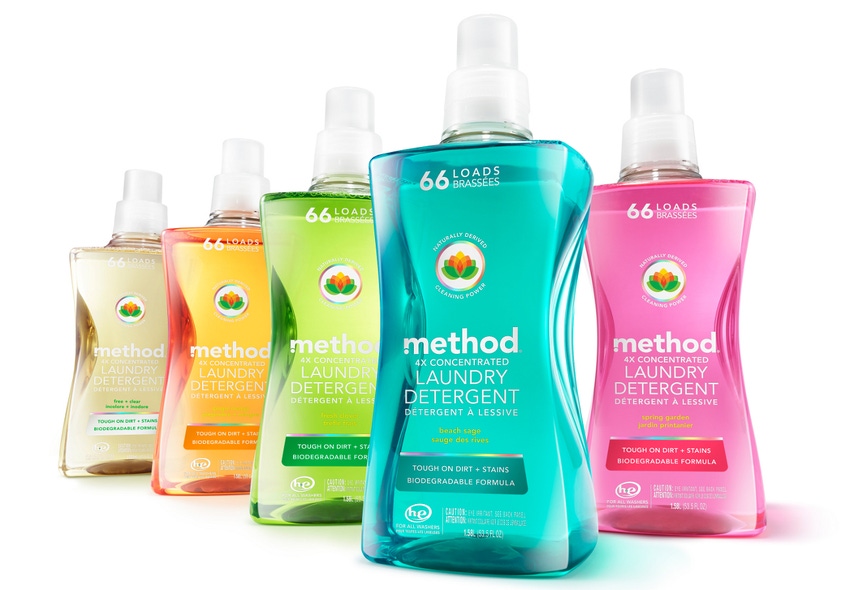
Few companies do sustainable packaging better than Method Products, which specializes in earth-friendly cleaning products and packaging design. Case in point: Method’s new 4X Concentrated Laundry Detergent comes in a sculpted bottle made of 100% post-consumer recycled (PCR) PET.
Amcor Rigid Plastics, which supplies the 53-oz. stretch blow molded bottle, claims it is the first liquid laundry detergent bottle to be made of 100% PCR PET. The category historically has been dominated by opaque high-density polyethylene (HDPE) containers.
The Method package is a head-turner at retail, standing out from competitive products on the basis of both clarity and structural design. Method’s transparent bottle puts the jewel-like colors of the 4X concentrated products on display, and the package’s sculptural lines make a strong visual statement. For ease of handling, an ergonomic pinch grip is molded into the sides of the bottle.
The package’s two-piece polypropylene closure, supplied by Menshen,incorporates a pour spout and measuring cup. A lug molded into the bottleneck assures that the pour spout remains in the front and center of the bottle, not rotating when the cup is removed.
Joe Hunter, Method’s director of packaging (a.k.a., pack-daddy), shares some details about the package, which launched in April.
Why isn’t PET ordinarily used for liquid laundry detergent? How did Method overcome that with this package?
Hunter: There are a number of compatibility issues, in addition to formulas that are typically not very appealing to show off in clear bottles. Our green chefs were able to formulate a product that solved both of those issues.
Method uses 100% PCR PET bottles for other cleaners, right?
Hunter: Yes, many of our cleaners come in PET bottles—all of which are made of 100% PCR PET.
How is Method communicating to consumers its feat of creating a 100% PCR PET bottle for this category?
Hunter: We are really letting that aspect speak for itself. This line of products does a great job of standing out from the crowd in a laundry aisle filled with opaque HDPE bottles.
Why did Method choose to create such a different looking container for the category?
Hunter: The laundry aisle tends to be filled with very similar packaging. We wanted to do something that stands out and works really well with a clear PET bottle, so we put our Method twist on laundry and created this new format.
Why didn’t you put a handle on the bottle?
Hunter: A handle wasn’t an option using PCR PET, so we developed the pinch grip—a win-win, as it offers nice ergonomics and also allows the use of PCR PET.
How were you able to incorporate the back label, in view of the pinch grip?
Hunter: The pinch grip is mostly designed into the sides of the bottles, which left the whole back panel open for labeling.
Why was the pour-spout orientation so important?
Hunter: We wanted to make sure when you pick up the bottle from the grip, you pour exactly from the opposite side, so there would be no ergonomic issues.
Why not use a pump-dosing closure, like the one on Method 8X Laundry Detergent bottles?
Hunter: A pump is more difficult to use with a bottle this size, and it’s also already something we offer in our 8X detergent. The pour spout is something consumers are more accustomed to in laundry, and it offers different benefits to our consumers within our laundry portfolio.
Will you be switching 8X to a 100% PCR PET bottle? What plastic is the 8X bottle made from currently?
Hunter: No plans to make any changes to 8X; it is currently packaged in HDPE (50% PCR).
Where is the 4X product sold?
Hunter: Target, Harris Teeter, Jewel and other select grocery and drug stores; and e-commerce sites, including Amazon.com and MethodHome.com.
About the Author(s)
You May Also Like




